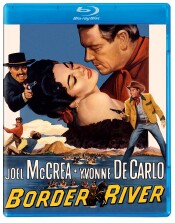“During the war between Maximillian and Juarez in 1865 there was a small territory on the Mexican side of the Rio Grande River known as Zona Libre – Free Zone. It was dominated by a man who called himself General Eduardo Calleja, and he made it a haven for any man outside the law. This is the story of Zone Libre.”
Clete Mattson (McCrea) is swimming across the Rio Grande to the place Zona Libra with Union cavalry soldiers hot on his tail. They’re shooting at him while men on the Zona Libre side makes bets on whether he’ll make it. One of those bets is placed by Carmelita (De Carlo). She rushes to his side as he collapses on the riverbank. He’s alive and is taken to be cared for. The General (Armendariz) agrees to meet with the man calling himself Jim Lake. But he already knows his real name and why he’s here. He’s a Confederate leader who has stolen $2 million in gold from the Union troops. He’s here to use that gold to buy arms and supplies for the Confederate army. Of course, the General would very much like to get his hands on the gold for himself. He’s not the only one. As word spreads, quite a few of the town’s population of crooks want in on the deal. Clete demands fair exchange for the money and is willing to hold out until he gets it. Once a deal has been made, it’s time to retrieve the gold. All the while he has been getting closer to Carmelita, who is the General’s girl. But too many people know about the gold, and the film becomes a chase to get the gold.
The film takes advantage of its Utah settings to create an authentic feel for the environments it portrays. The Colorado river substitutes for the Rio Grande, so there’s a ton of production value without having to spend so much to get it. Joel McCrea plays Clete. He’s been in a ton of films, many of them westerns, but was likely most noted for his role in The Most Dangerous Game with Fay Wray and Robert Armstrong. It was actually filmed in the same locations and at pretty much the same time as King Kong, using much of the same cast. Clete also saw his son Joel McCrea get his first screen role here. The female lead of Carmelita is played by Yvonne DeCarlo, who is perhaps best known for her role as Lily in The Munsters but has a pretty impressive list of dramatic roles including The Ten Commandments with Charlton Heston and a truly all-star cast that included Vincent Price, Yul Brynner, Edward G. Robinson, John Carradine, and Sir Cedric Hardwicke, and of course directed by Cecil B. DeMille. DeCarlo and McCrea have a lot of great chemistry here, and that’s not much of a surprise when you consider they co-starred together also in The San Francisco Story two years earlier.
The supporting cast has a few gems. Alfonso Bedoya is actually pretty compelling as the somewhat amusing Captain Vargas. Meanwhile, Pedro Armendariz, Jr. is convincing as the corrupt General Calleja, who runs the free zone for his own profit, of course. Both men stand out in roles that by this time had become somewhat stereotypical and not necessarily flattering to Mexicans. They both manage to infuse some personal character into the thinly written parts. Without that kind of performance, McCrea would have had a hard time shining without some kind of a worthy adversary. Of course, they make up for any deficit by giving him any number of bad guys to go against, and part of the charm of the movie is trying to figure out who is a good guy, particularly when your hero is a Confederate soldier.
Finally director George Sherman gets the most out of his cast and the location environments. There are two exceptionally shot scenes that will stand out long after you’ve forgotten the movie. The opening salvo of Union soldiers chasing McCrea and shooting as he tries to reach the “friendly” bank of the river is a nice way to open the film and build some of both the drama and the quickly forged relationship with DeCarlo. There’s also a scene later when McCrea is going to check on the gold where his horse gets trapped in quicksand. He fights and manages to free the horse, but it’s quite a powerful image. The quicksand will also become an important story point that gives away his actions to some of the bad guys. Sherman had a ton of experience. He worked with McCrea before on The Lone Hand and had been directing westerns since 1937. This film has some historical significance. It was the final major motion picture to be shot in the 3-strip Technicolor process. That’s a lot of information right there. “Information! Information! Everyone has an information!”



